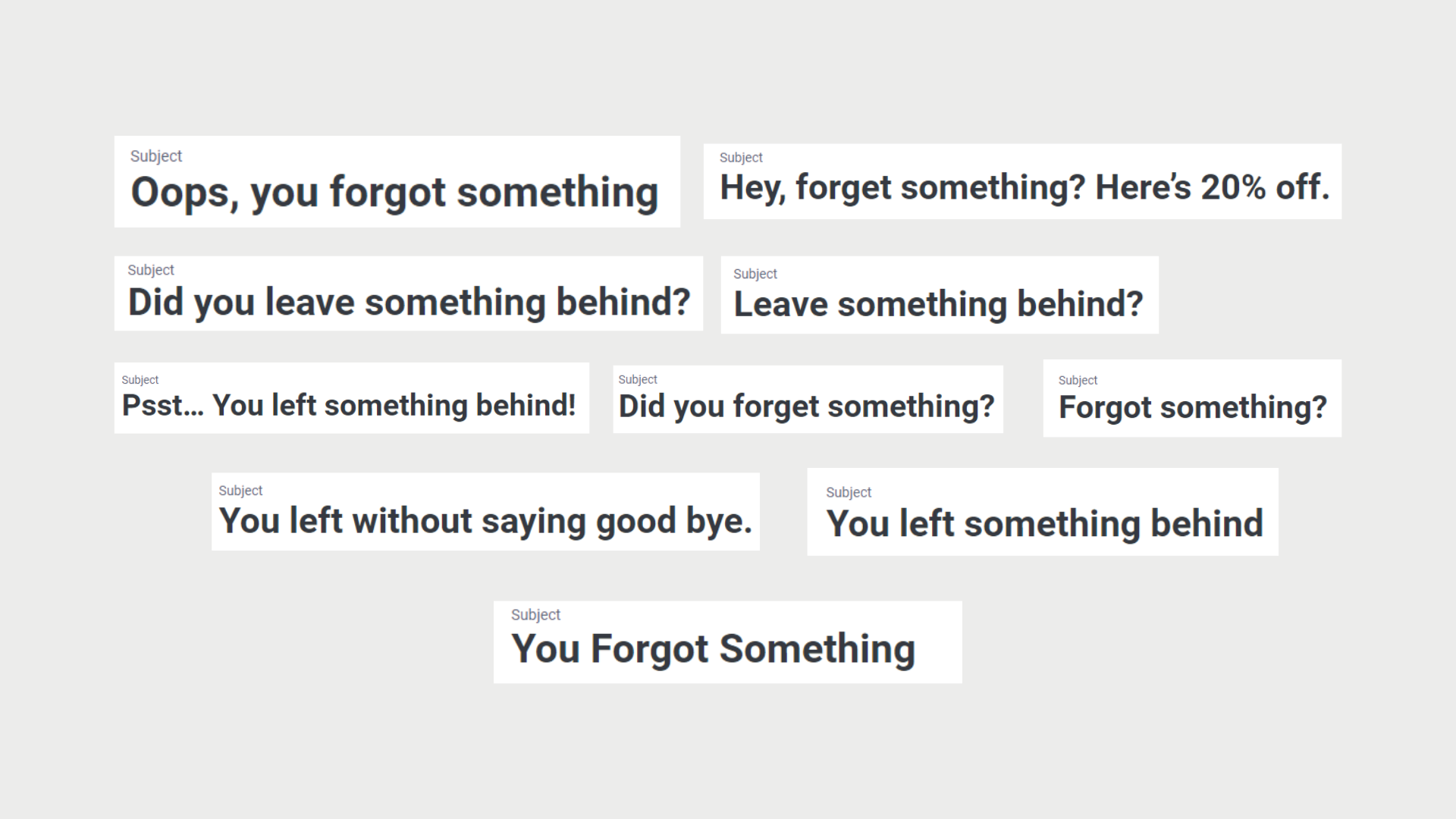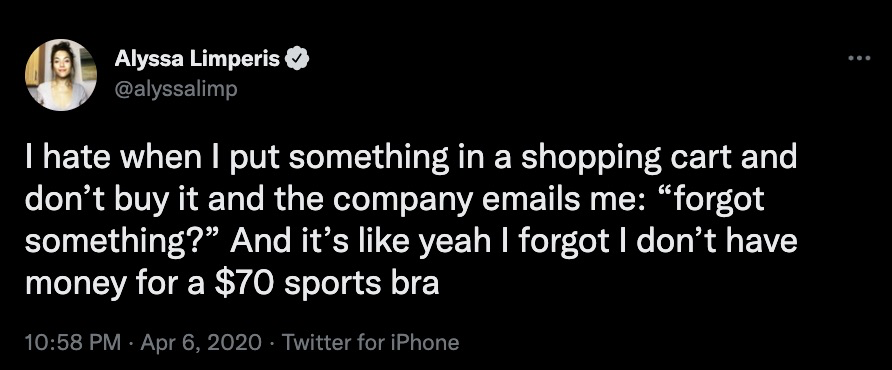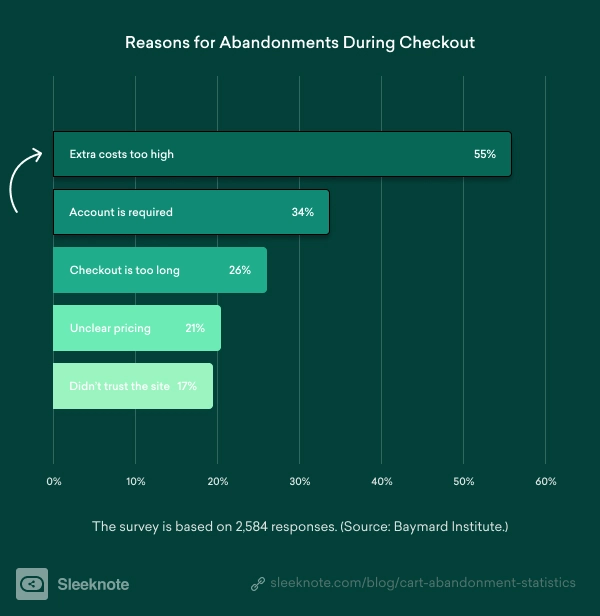Ever gone online shopping, added items to your cart, and left without completing your order?
Don’t worry, we’ve all done it. And it’s what the ecommerce world calls abandoning a cart.
It’s the online equivalent of window shopping and your fundamental right as an online shopper.
And just as we’ve all abandoned carts online, we’ve also received emails saying some version of “Hey, you forgot something” or “We saw you looking 👀.”
These emails are called abandoned cart emails.
Typically, they display the products left in your cart and encourage you to buy before your cart empties, someone else scoops up the products you were interested in, or the items go out of stock.
There’s often a discount offered to get you to complete your order.
And the best part? These emails convert!
In fact, customers who add items to a cart or who start the checkout process are a lot closer to the sale than someone who’s just browsing. And by adding things to their carts, they’re indicating an intent to buy.
So, what's the catch?
The creep factor of abandoned cart emails
No matter how you look at it, abandoned cart emails are creepy (someone had to say it).
Brands are literally emailing customers to, more or less, let them know they’re being tracked. We know what you did on our website. Now come back and finish what you started—please.

In our eagerness to win back customers, we forget that email marketing is all about customer experience and building trust. This includes abandoned cart emails.
Because sometimes people mean to abandon a cart

For customers like Alyssa, sending abandoned cart emails won’t work because they meant to abandon their cart.
The reasons for abandoning could be anything. Maybe they added items to their cart as a way to bookmark products to look at later. Maybe they weren’t sure and added them so they could decide in a few days. Or maybe they just didn’t have the money to spend in the first place, but adding things to a cart can feel just as satisfying as actually purchasing them (without buyer’s guilt) so they did it anyway.
For these customers, abandoned cart emails feel creepy and they miss the mark by a mile.
So, how do we make abandoned cart emails less creepy (and more on target)?
More importantly, how do we find out which customers meant to abandon their cart and make them feel seen, understood, and (dare we say it) less creeped out?
An abandoned cart email workflow done right
If done well, your abandoned cart emails will be one of your top money-making email workflows (Remember those stats we shared earlier?). They can also be an opportunity to turn skeptical customers into loyal, raving fans.
The reason abandoned cart emails convert so well is that they reflect intent to buy. Someone was interested enough in your products that they added them to a cart or started the checkout process.
And yet, this doesn't mean you bombard them with emails and use every available method to strong-arm them into buying.
If you did, you'd be sacrificing their long-term loyalty for short-term profit. If you want to maximize both brand loyalty and brand profit, you need to treat your customers well and give them an email experience they won’t forget. Even if they don’t end up buying from you (this time, that is).
Remember, the best email experience is the one that puts its customers first. And when we don’t know exactly why someone’s not doing what we want them to do, we need to:
- Find out why they’re not converting
- Give them a way to tell us why they’re not buying
- Allow them to customize their email experience
Give them the option to opt-out
Give your customers a chance to opt out and tell you "Thanks, but I meant to abandon this cart."
Focusing on customer experience or making your customer feel seen and understood doesn’t need to be complicated. You don’t even need to redo your current abandoned cart workflow.
Just add a P.S. at the bottom of your emails saying “Meant to abandon your cart? We do that too! Click here to let us know so we don’t send you any more reminders.”
Simple, friendly, pressure-free.
The people who were going to convert from your abandoned cart emails will still convert. All this opt-out business does is filter out the folks who had no plans of buying in the first place, and improve their email experience.
The best part? Treating your subscribers like actual people helps you stand out from the crowd. Even if they don’t buy, they’ll remember you.
With a single P.S., you’ll turn your abandoned cart emails into friendly reminders that entice and sell, instead of annoy.
Send a personalized follow-up email
If you’re letting people opt out of your abandoned cart emails, how are you going to find out why they meant to abandon their cart?
Here’s where a follow-up email works quite well. Thank the person for letting you know that they aren’t interested in receiving your abandoned cart emails, then use this opportunity to ask them why.
Keep it simple (text only) and make it look like a personal email from someone at your brand.
“Hey, thanks for letting us know. Here at [brand], we’re always working to improve our products/offers/customer experience.
Would you mind telling us why you decided not to complete your purchase?
FYI, just browsing is a totally legitimate reason! ;)
Just hit reply to let me know!”
This is what we call a “proactive customer support” email. It gives you:
- The qualitative data you need to figure out how your customers feel.
- The insights you need to adapt your offers
- The opportunity to create a connection with a customer
How you set up these follow-up emails is totally up to you. You can let people choose a reason by offering them a few options, or you can send a one-question survey, or simply ask them to reply to your email.
You can even be cheeky and ask them if a discount would help. (This is especially effective if you’re not offering a discount in the first abandoned cart email.)
Use non-creepy subject lines
We touched on this earlier, but, it’s worth repeating: there’s a certain level of creepiness associated with abandoned cart emails.
Let’s say you’re a shoe brand. Instead of sending out abandoned cart emails with subject lines like “Hey, you left something behind” or “We saw you looking”, use subject lines that are friendly and make your customers feel good. Something along the lines of:
- Love shoes? Us too! 🥂
- Psst… these shoes will look great on you.
- You’ve got great taste {first name}. 😍
- Still thinking about those shoes?
- To buy or not to buy… 🤔
Adapt these subject lines to mention your offer (if you’re making one) in your abandoned cart emails, or use the preview text to add in those details.
Either way, think of your emails as a communication tool, and the people receiving your emails as friends you’re having an IRL conversation with.
Doing so will go a long way in helping reduce the creep factor of your abandoned cart emails.
Figuring out what offer to make in your abandoned cart emails
According to Statistica, people abandon carts for a variety of reasons:

Letting your customers tell you why they’re not completing their orders will allow you to create an offer they’ll actually want.
If the majority of your customers are abandoning carts on your website because the shipping cost is too high, a 10% discount won’t be enough to convince them to buy. Offering free shipping, on the other hand, converts like nothing else does.
Using Drip to create your abandoned cart workflow
Drip’s pre-built email workflows make it extremely simple to set up your abandoned cart emails.
And because we’ve just shown you a bunch of ways to optimize your abandoned cart emails, the next logical step is to split test everything.
From testing subject lines and email copy to testing offers and send times, you’ll be able to make informed decisions in no time.
And the best part (so many best parts in this lesson)? You can split-test right inside your automated workflows!
Wrap up
To recap, here’s a quick overview of the main points to keep in mind:
- Abandoned cart emails are creepy, but they don’t need to be.
- Sometimes customers intentionally abandon their carts.
- Give customers more control by letting them opt out of receiving your abandoned cart emails.
- Asking customers if they meant to abandon a cart elevates the email experience and gives you the insights you need to make informed decisions.
- If someone tells you they meant to abandon a cart, send a personalized email asking the reason.
- Make your subject lines conversational instead of awkward (or creepy).
- Email copy plays a big role in making abandoned cart emails feel less creepy.





